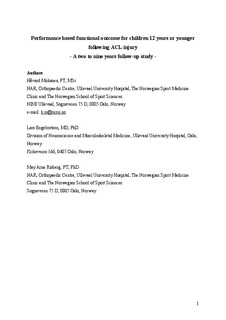Performance-based functional outcome for children 12 years or younger following anterior cruciate ligament injury : a two to nine-year follow-up study.
Peer reviewed, Journal article
Permanent lenke
http://hdl.handle.net/11250/170447Utgivelsesdato
2007-12-22Metadata
Vis full innførselSamlinger
- Artikler / Articles [2119]
Originalversjon
Knee Surgery, Sports Traumatology, Arthroscopy. 2008, 16(3), 214-223Sammendrag
There is limited scientific knowledge on ACL injuries in children 12 years or younger.
Substantial controversy exists on treatment algorithms and there are no published data on
performance based functional outcome. Classification of adult ACL injured subjects as copers and non-copers is common, but no study has classified knee function in children using performance based functional test after ACL injury. The aim of the present study was to evaluate the long term functional outcome among children with ACL injury, and to classify them as copers and non-copers. Children 12 years or younger who were referred to our institution from 1996 to 2004 with an ACL injury were included. Twenty non-operated subjects (21 knees) and six ACL reconstructed subjects (7 knees) were examined at a minimum of two years after ACL injury or reconstruction. Four single legged hop tests, isokinetic muscle strength measurements, and three functional questionnaires (IKDC 2000, KOS-ADLS and Lysholm) were used as outcome measurements. Children who had resumed their pre-injury activity level and performed above 90% on all hop tests were classified as copers following non-operative treatment and ACL reconstruction. The 26 children were on average 10.1 years at time of injury. Sixty-five percent of the nonoperated children had returned to pre-injury activity level, and 50% were classified as copers. Copers scored significantly better than non-copers on single hop for distance, IKDC 2000, and Lysholm score. Nine and a half percent of the non-operated children had suffered a
secondary meniscus injury. Sixty-seven percent of the ACL reconstructed subjects were classified as copers at follow-up.
Non-operated ACL-deficient children demonstrated excellent knee function on performance based single legged hop tests and 65% had returned to pre-injury activity level. Delayed ACL reconstruction resulted in success for a majority of the ACL reconstructed children. Treatment
algorithms for ACL injured children are discussed.
Beskrivelse
I Brage finner du siste tekst-versjon av artikkelen, og den kan inneholde ubetydelige forskjeller fra forlagets pdf-versjon. Forlagets pdf-versjon finner du på www.springerlink.com: http://dx.doi.org/10.1007/s00167-007-0469-7 / In Brage you'll find the final text version of the article, and it may contain insignificant differences from the journal's pdf version. The original publication is available at www.springerlink.com: http://dx.doi.org/10.1007/s00167-007-0469-7
